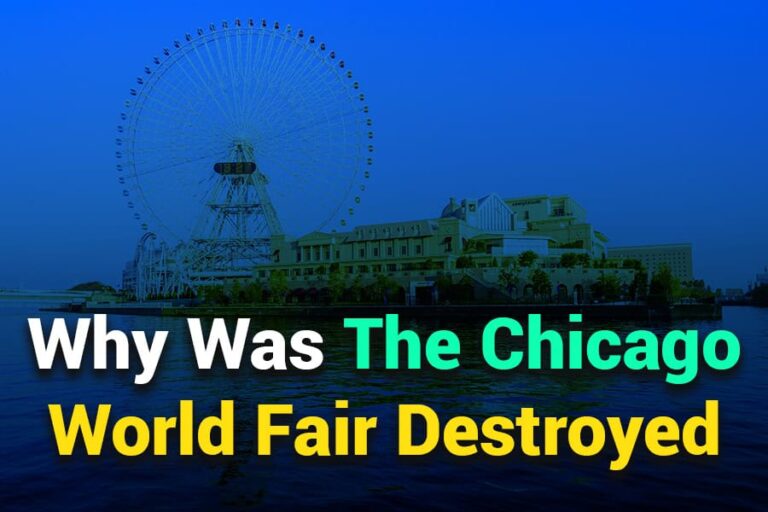The Chicago World Fair of 1893, also known as the World’s Columbian Exposition, was a monumental event that showcased the progress and industrial prowess of the United States. However, its destruction became a pivotal historical moment, leading to various social, economic, and political implications. Why was the Chicago World Fair destroyed? This article dives deep into the reasons behind its demise, exploring factors such as economic pressures, political turmoil, and changing societal dynamics. Understanding the events that led to the fair’s destruction gives us insight into a crucial turning point in American history.
Why Was the Chicago World Fair Destroyed?
The Chicago World Fair, also known as the World’s Columbian Exposition of 1893, was destroyed due to economic, political, and societal factors. Economic recession, political instability, and local unrest contributed to its closure and eventual destruction. The fair was also marred by financial troubles and a fire that devastated several buildings, ultimately marking the end of a historic event.
Historical Context of the Chicago World Fair
The Chicago World Fair, held in 1893, was a landmark event celebrating the 400th anniversary of Christopher Columbus’s arrival in the New World. Spanning 690 acres, the exposition featured architectural marvels, technological advancements, and a glimpse into the future of a rapidly industrializing America. However, despite its grandeur, the fair-faced various challenges from the outset. Financial struggles, political debates, and societal issues were present throughout the event. The fair’s ambitious scope was undermined by economic constraints, leading to tensions among organizers, exhibitors, and visitors. Political leaders also had differing visions of what the fair should represent, adding to the challenges.
In addition to economic and political issues, the fair also dealt with social controversies. Debates over race, labor, and immigration policies influenced the atmosphere, making it a microcosm of the broader societal struggles of the time. These underlying tensions set the stage for the fair’s eventual downfall, demonstrating that even a symbol of progress and unity could be vulnerable to internal strife.
The fair also significantly impacted Chicago’s infrastructure and economy. While it brought in substantial revenue and tourist traffic, the costs of hosting such a massive event strained local resources. The fair ended up leaving the city with considerable debt, further contributing to its failure.
Events Leading to the Fair’s Destruction
Economic Recession
The Panic of 1893 struck during the fair’s run, causing a nationwide economic crisis. Many visitors could no longer afford the trip, resulting in decreased ticket sales and revenue.
Labor Unrest
Labor disputes were rampant during the fair. Workers demanded better wages and working conditions, leading to strikes that disrupted the fair’s operations.
Political Instability
Local political disputes also affected the fair’s success. Conflicts between city officials and fair organizers over funding and management created delays and inefficiencies.
Fire and Other Accidents
A devastating fire broke out on the grounds, destroying several pavilions and exhibits. This disaster highlighted the vulnerabilities in construction and planning, hastening the fair’s closure.
Social Controversies
The fair also faced backlash for its portrayal of indigenous cultures, treatment of minority workers, and exclusion of women from certain exhibits, all of which fueled public criticism.
Why Did the Fair Close?
- Financial Losses: The fair incurred massive financial losses, contributing to its closure.
- Low Attendance: The economic recession led to lower-than-expected attendance, worsening the fair’s financial issues.
- Unresolved Labor Issues: Strikes and protests by workers further strained resources.
- Political Pressure: Local political issues added to the complexity of managing the fair effectively.
- Fire Damage: The fire led to irreparable damage to the fairgrounds, hastening its end.
Long-term Impacts of the Fair’s Destruction
The destruction of the Chicago World Fair had lasting impacts on the city and the nation. Economically, the city faced debts and a slowed recovery from the recession. Politically, it exposed the challenges of organizing large-scale public events, highlighting the need for better city planning and disaster preparedness. Socially, the fair’s failure underscored the limitations of America’s industrial progress and the growing divide between different social classes. It also influenced future world fairs, leading to more cautious planning and consideration of economic conditions.
The fair’s fall also had cultural implications, shaping public perception of progress and innovation. While the exposition initially symbolized hope and the American Dream, its destruction became a metaphor for the fragility of that dream in the face of economic and social challenges.
Lessons Learned from the Chicago World Fair
- Economic Planning: Large events should account for potential economic downturns to mitigate financial risks.
- Labor Rights: Addressing labor concerns is crucial to ensuring smooth operations for major events.
- Fire Safety Measures: Improved fire safety protocols and construction standards are essential for public safety.
- Cultural Sensitivity: Ensuring fair representation of different cultures and communities can enhance public acceptance and reduce controversies.
- Political Collaboration: Successful events require cooperation between organizers and political authorities to ensure smooth operations.
Warping Up
The destruction of the Chicago World Fair was a complex event influenced by economic, political, and social factors. Multiple issues contributed to its premature end, from financial struggles to labor unrest and fire disasters. The fair serves as a lesson in planning, collaboration, and cultural sensitivity, highlighting how even the grandest visions can falter without careful execution. Understanding why the Chicago World Fair was destroyed helps us learn from history’s mistakes and recognize the importance of adaptive strategies for large-scale events.
FAQ’s
Was the Chicago World Fair financially successful?
A. Despite initial success, the fair-faced financial challenges incurred significant losses due to low attendance and operational costs.
How did the fire contribute to the fair’s downfall?
A. The fire caused severe damage to several pavilions, highlighting construction flaws and accelerating the fair’s closure.
What were the social controversies surrounding the fair?
A. The fair-faced criticism for its portrayal of indigenous cultures, treatment of minority workers, and limited representation of women.
